Hops in Beer Brewing: Toyomidori
Published: September 24, 2025 at 3:21:47 PM UTC
Toyomidori is a Japanese hop variety, bred for use in both lagers and ales. It was developed by Kirin Brewery Co. in 1981 and released in 1990. The goal was to increase alpha-acid levels for commercial use. The variety comes from a cross between Northern Brewer (USDA 64107) and an open-pollinated Wye male (USDA 64103M). Toyomidori also contributed to the genetics of the American hop Azacca. This shows its significant role in modern hop breeding.
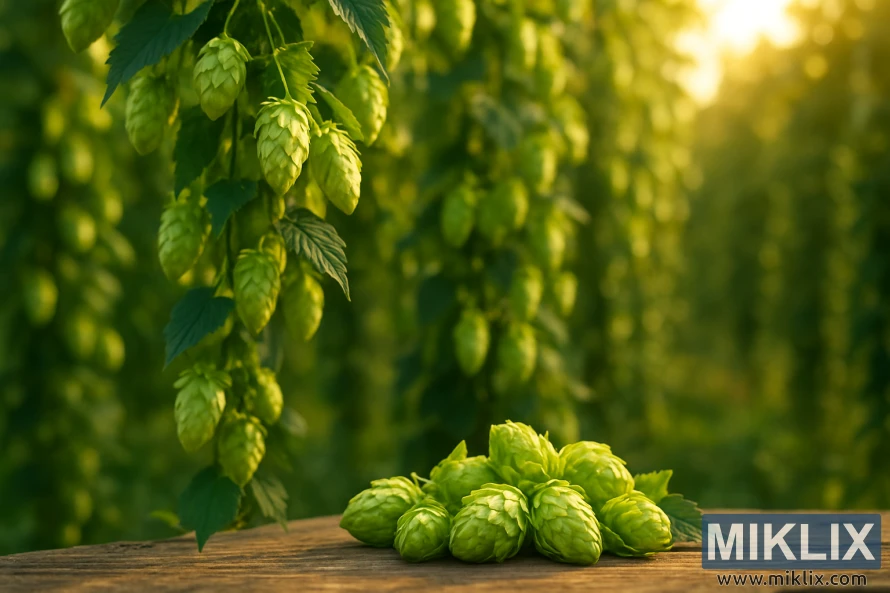
Known also as Kirin Flower and Feng Lv, Toyomidori hop brewing emphasizes stable bitterness. It was once part of a high-alpha program with Kitamidori and Eastern Gold. Yet, its susceptibility to downy mildew limited its wider adoption, reducing acreage outside Japan.
Availability of Toyomidori Hops can vary by harvest year and supplier. Some specialty hop merchants and larger marketplaces list Toyomidori Hops when stock permits. Brewers should expect fluctuating supply and consider seasonality when planning recipes.
Key Takeaways
- Toyomidori Hops originated in Japan for Kirin Brewery Co. and were released in 1990.
- Primary use is as bittering hops, not aroma hops in Toyomidori hop brewing.
- Parentage includes Northern Brewer and a Wye open-pollinated male; it is also a parent of Azacca.
- Known aliases include Kirin Flower and Feng Lv.
- Supply can be limited; check specialty merchants and marketplaces for availability.
Why Toyomidori Hops Matter for Craft Brewers
Toyomidori is a standout for its bittering hop importance in many recipes. It offers moderate-to-high alpha acids, making it a go-to for brewers seeking a clean, efficient bittering addition. This ensures the target IBU is reached without overpowering the hop flavor.
Its primary brewing role is bittering, with many recipes allocating Toyomidori for about half the hop bill. This simplifies hop selection for brewers, aiming for a balance between bitterness and subtle aroma.
- Mild fruity notes that support malt character.
- Hints of green tea and tobacco that add complexity.
- Relatively high alpha percentage for sharper bitterness control.
Understanding Toyomidori's benefits aids brewers in crafting recipes where it serves as a backbone, not a centerpiece. Used early in the boil, it provides stable, long-lasting bitterness. The herbal and fruit notes are faintly present in the background.
The variety's lineage from Kirin's breeding work is notable. It shares genetic ties to Azacca and Northern Brewer, providing insight into expected flavor markers. This knowledge helps predict how Toyomidori will interact with various malts, whether American or British.
Practical considerations include supply variability and a history of downy mildew susceptibility. Smart hop selection involves checking availability, sourcing from reputable suppliers, and planning for substitutions or blends in large-scale production.
Toyomidori Hops
Toyomidori was developed for Kirin Brewery Co. in Japan, debuting in 1981. It hit the market in 1990, known by codes like JTY and names such as Kirin Flower and Feng Lv.
The origins of Toyomidori stem from a cross between Northern Brewer (USDA 64107) and a Wye male (USDA 64103M). This genetic mix aimed for high-alpha content while preserving strong aroma characteristics.
The creation of Toyomidori was part of a broader effort by Kirin to expand its hop varieties. It later became a parent to Azacca, further enriching the Kirin hop family.
Agronomically, Toyomidori matures mid-season, with yields around 1055 kg per hectare (about 940 lbs per acre) in some trials. Growers observed a rapid growth rate but noted its susceptibility to downy mildew, limiting its cultivation in many areas.
- Produced for Kirin Brewery Co. (1981); commercial from 1990
- Genetic cross: Northern Brewer × Wye male
- Also known as Kirin Flower, Feng Lv; international code JTY
- Parent of Azacca; linked with other Kirin hop varieties
- Mid-season, good yields reported, mildew susceptibility limits production
Specialty suppliers and select hop stocks continue to offer Toyomidori to brewers. Its unique heritage makes it appealing to those interested in the history of Kirin hop varieties.
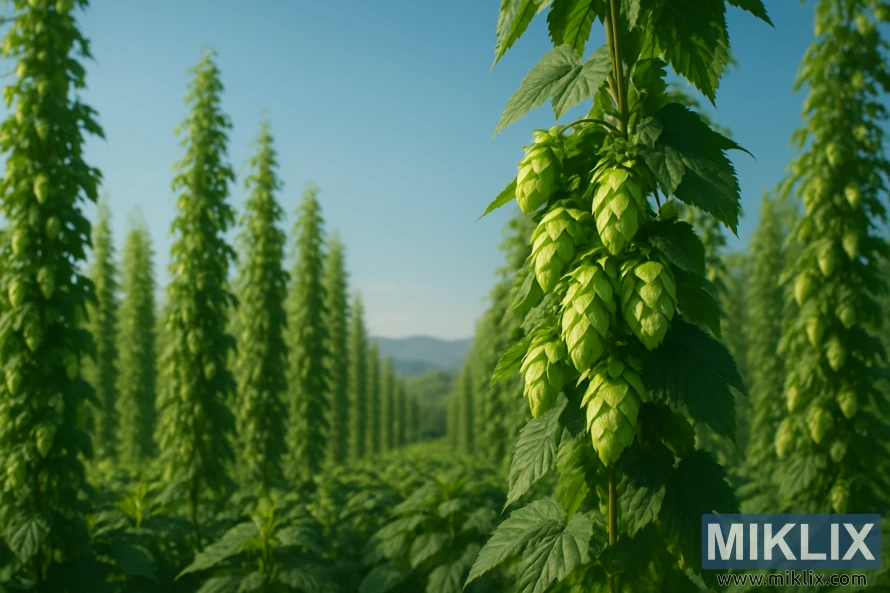
Flavor and aroma profile of Toyomidori
Toyomidori presents a mild, approachable hop aroma that many brewers find understated and clean. Its character is marked by gentle fruity notes, with hints of tobacco and green tea.
The oil content ranges from 0.8–1.2 mL per 100 g, averaging about 1.0 mL/100 g. Myrcene, making up 58–60%, dominates the resinous and citrus-fruity aspects. This is before other elements emerge.
Humulene, at roughly 9–12%, introduces a light woody, noble spice edge. Caryophyllene, near 4–5%, adds subtle peppery and herbal tones. Trace farnesene and minor compounds like β-pinene, linalool, geraniol, and selinene contribute delicate floral, pine, and green nuances.
Given its modest total oils and myrcene dominance, Toyomidori is best for early bitterness additions. Late additions can provide a mild aroma lift. Yet, the hop aroma remains more subdued than intensely aromatic varieties.
- Primary descriptors: mild, fruity, tobacco, green tea
- Typical role: bittering with light finishing presence
- Aromatic impact: restrained, shows fruity hop notes when used late
Brewing values and lab data for Toyomidori
Toyomidori alpha acids typically range from 11–13%, with averages around 12%. Grower reports, though, can show values as low as 7.7%. This indicates significant variability between batches.
Beta acids usually fall between 5–6%, leading to an alpha:beta ratio of 2:1 to 3:1. This ratio is critical in determining the bitterness profile, impacting IBUs for kettle additions.
- Co-humulone: about 40% of alpha acids, a higher share that can change perceived bitterness.
- Total oil: roughly 0.8–1.2 mL per 100 g, often listed as 1.0 mL/100 g on hop lab data sheets.
- Typical oil makeup: myrcene ~59%, humulene ~10.5%, caryophyllene ~4.5%, farnesene trace ~0.5%.
Hop Storage Index values for Toyomidori commonly measure around 0.37. This indicates fair storability, with about 37% alpha loss after six months at 68°F (20°C). Fresh hops retain alpha potency best.
Yield and harvest numbers place Toyomidori at mid-season maturity. Recorded agronomic figures show roughly 1,055 kg/ha, about 940 lbs per acre, for commercial plots.
Practical brewers who rely on hop lab data should test each lot. Year-to-year crop variation can shift Toyomidori alpha acids and total oil. This will change aroma and bittering outcomes in a recipe.
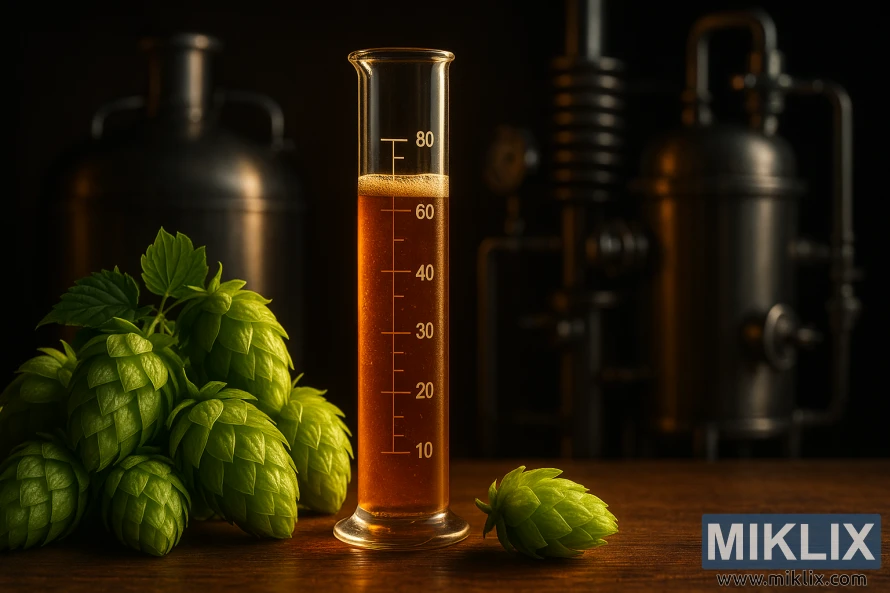
How to use Toyomidori Hops in recipes
Toyomidori is most effective when added early in the boil. For a solid bitter foundation, include hops between 60 to 90 minutes. This allows for the isomerization of alpha acids, setting the bittering profile. Many recipes, both commercial and homebrew, treat Toyomidori as a primary bittering hop, not just a late aroma addition.
In crafting a hop bill, Toyomidori should dominate the hop weight. Studies indicate it typically constitutes about half of the total hop additions. Adjust this proportion based on the alpha acid percentage listed on the hop label.
Reserve late and whirlpool additions for subtle nuances. Toyomidori's modest total oils and myrcene-forward profile make it suitable for late-stage use. This results in light fruity, green-tea, or tobacco notes, not intense tropical or citrus aromas. Dry-hop impact should be tempered.
- Primary addition: 60–90 minute boil for bittering schedule control.
- Proportion: start with ~50% of hop bill when pairing with other varieties.
- Late use: small whirlpool or dry-hop doses for gentle herbal or green character.
Format and supply influence dosing. Toyomidori is available as whole cone or pellets from reputable suppliers. There are no widespread cryo or lupulin powder versions, so recipes should be based on pellet or whole-leaf utilization rates.
When substituting Toyomidori, adjust for alpha acid content. Match bitterness by calculating AA% and adjusting weight or boil time. Always check the lab AA% on the purchased lot to ensure accurate bittering schedule.
For brewers seeking clarity, pair Toyomidori with hops known for bright esters or citrus notes. Use Toyomidori for structure, then balance with late additions from high-oil varieties. This approach maintains bitterness while introducing aromatic contrast.
Style pairings and best beer styles for Toyomidori
Toyomidori excels when it provides a steady, clean bitterness without dominating the aroma. It's a go-to hop for brewers seeking reliable alpha acid performance and a neutral base. It's ideal for recipes where subtle vegetal, green-tea, or mild fruity notes won't clash with malt or yeast.
Classic pale ales and English-style bitters are perfect matches for Toyomidori. These beer styles allow the hop to add faint tobacco or tea tones without overwhelming the palate. Toyomidori is also commonly used in amber ales and session beers for its bittering role.
In lagers, Toyomidori offers a crisp, controlled bitterness that supports clean lager fermentation. It's a favorite among brewers for pilsners and European-style lagers, providing stability in alpha-driven bitterness while keeping hop aroma minimal.
- Pale ales and bitters — reliable bittering, subtle background flavor
- Amber ales and malt-forward styles — complements caramel and toasty malts
- European lagers and pilsners — steady alpha acids for crisp finish
- Session beers and seasonal brews — supports restrained, balanced profiles
Toyomidori IPAs often feature this hop as part of the hop bill, not the star. Here, Toyomidori plays a background bittering role, while aromatic hops like Citra, Mosaic, or Cascade add topnotes. Use Toyomidori for roughly half of total hop additions to achieve consistent bitterness without aggressive flavor.
When crafting recipes, consider Toyomidori as a backbone hop. It typically makes up 40–60% of hop additions to ensure stable bitterness. Pair it with citrusy or resinous hops sparingly for a restrained IPA with clean bitterness and layered aroma.
Substitutes and hop pairing options
Data-driven tools are essential for finding Toyomidori substitutes. Many databases lack direct swaps, so compare alpha-acid, essential oil percentages, and cohumulone. This helps find the closest match.
For a Northern Brewer alternative, look at medium-high alpha bittering hops. They should have similar oil ratios and cohumulone levels. Toyomidori's parentage suggests finding functional replacements, not exact aroma clones.
Here are practical steps for swapping hops:
- First, match alpha-acid contribution and adjust batch formula for AA% differences.
- Compare myrcene, humulene, and caryophyllene levels to mimic bitterness and mouthfeel.
- Run small-scale trials to judge aroma and flavor changes in your recipe.
When pairing hops, use Toyomidori as a flexible bittering base. Pair it with neutral aroma hops for backbone support. Or, use mild citrus and floral varieties to add complexity without overpowering the beer.
Classic balance comes from combining Toyomidori with noble or woody varieties. These combinations stabilize herbal notes and lend a clean finish.
When planning hop pairings, list targets for bitterness, aroma lift, and oil profile. Adjust timing and dry-hop rates to fine-tune the character.
Dosage and typical usage rates
When using Toyomidori, treat it like any high-alpha bittering hop. Always check the lot's lab AA% before mixing. Alpha ranges typically fall between 11–13%, but some data show around 7.7%. Always use the actual AA% from the label for IBU calculations.
For ales and lagers, use Toyomidori at rates similar to other high-alpha hops. A good rule is 0.5–2.0 oz per 5 gallons, based on target IBUs and alpha. Adjust this lower if the lot's alpha is higher.
In many recipes, Toyomidori makes up about half the hop bill. If your recipe calls for two ounces total, expect about one ounce as Toyomidori. The rest is for flavor and aroma hops.
For precise hop usage, convert ounces to grams, even in small batches. For example, 1 oz per 5 gallons is about 5.1 g per gallon. Scale up or down based on your target bitterness and the hop lot's AA%.
- Estimate IBUs using measured AA% and boil time before finalizing Toyomidori dosage.
- Reduce quantity when lab AA is at the higher end of the reported 11–13% range.
- If the lot shows lower AA near 7.7%, increase weight proportionally to hit IBUs.
Hop additions per gallon vary by recipe type and target bitterness. For bittering, use conservative hop additions early in the boil. Then add smaller late additions for flavor. Track each batch's outcomes to refine future Toyomidori dosage and hop usage rates.
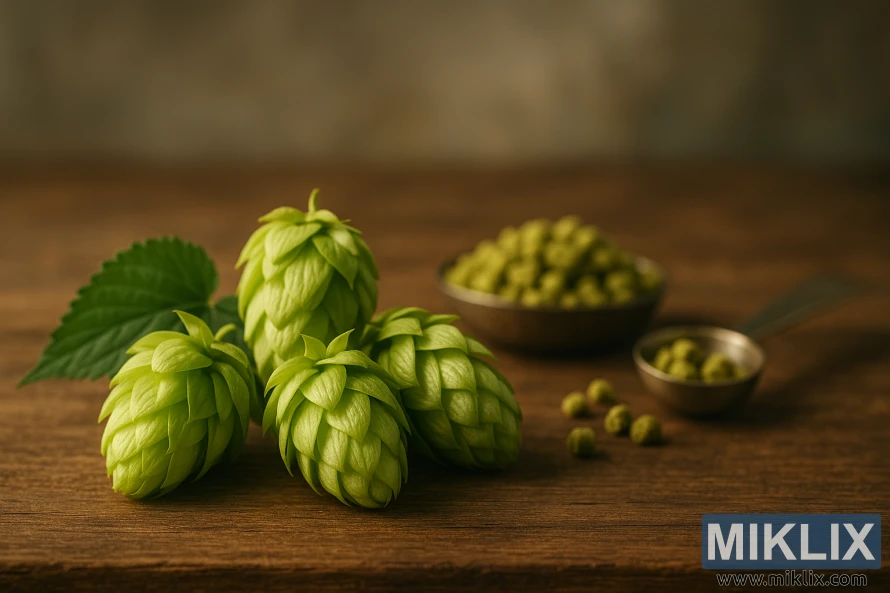
Growing and agricultural notes about Toyomidori
Toyomidori was bred in Japan for Kirin Brewery Co., alongside Kitamidori and Eastern Gold. This origin influences how growers cultivate Toyomidori, from trellis spacing to pruning timing.
Plants mature mid-season and grow vigorously, simplifying harvest. Field records indicate Toyomidori yields around 1,055 kg per hectare, or roughly 940 lbs per acre, under optimal conditions.
Growers find training and canopy fill straightforward. These traits enhance harvest efficiency and support consistent Toyomidori yields with proper site selection and nutrition.
Downy mildew is a significant concern. Historical data show moderate susceptibility, limiting plantings in some areas. Vigilance is key to managing hop diseases Toyomidori, with early application of integrated pest management protocols.
Preventive measures include using certified planting stock, ensuring good air flow, balanced nitrogen, and targeted fungicides where permitted. These steps help mitigate hop diseases Toyomidori and safeguard yield.
From an agronomic standpoint, Toyomidori exhibits fair storage stability. A trial showed about 63% alpha acid retention after six months at 20ºC (68ºF), with an HSI near 0.37. Cold storage enhances retention, preserving brewing quality.
Choosing the right site is critical. Opt for well-drained soil, full sun, and microclimates with lower humidity to reduce disease risk. Combining sound cultural practices with regular scouting ensures reliable Toyomidori cultivation and steady yields.
Storage, handling, and form availability
Toyomidori hops are available in whole-cone and pellet formats. Brewers should check inventory with suppliers like Yakima Fresh or Hopsteiner for planning. Currently, no lupulin powder or cryo-style concentrates are offered for Toyomidori, so choose between whole or pellet forms for your recipes.
For optimal preservation, store hops cold and sealed to slow down alpha-acid and oil loss. Vacuum-sealed bags kept at refrigeration temperatures yield the best results. Proper storage of Toyomidori ensures the preservation of its aromatic character and bittering qualities until brew day.
At room temperature, expect significant degradation. An HSI of 0.37 indicates a 37% drop in alpha and beta acids over six months without refrigeration. To maintain recipe consistency, plan stock rotation and use older lots sooner.
When handling hops in the brewhouse, treat Toyomidori as a bittering hop. Track the lot AA% to accurately calculate IBUs. Small variations in alpha acids affect hop weights and target bitterness.
- Label each lot with harvest year and lab analysis on arrival.
- Note storage method and date on the package to monitor potency over time.
- Record form (whole-cone or pellet) and adjust hop utilization in your system according to it.
Adjust recipes by using actual AA% from lab sheets for IBU calculations. This hop handling step prevents under- or over-bittering beers due to varying storage conditions between lots.
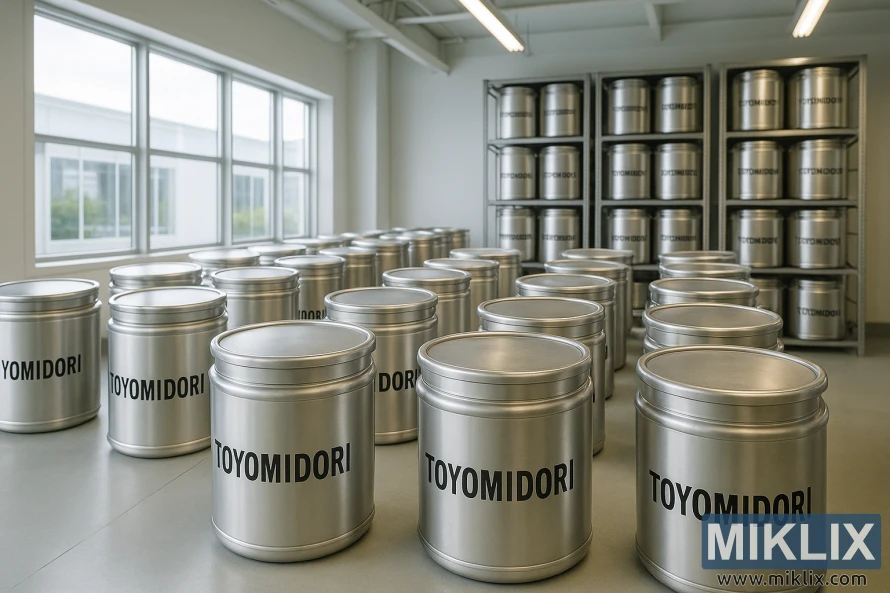
Where to buy Toyomidori hops and sourcing tips
Finding Toyomidori can be challenging. Look for specialty hop suppliers and craft-malt retailers for occasional listings. Online hop merchants and Amazon may also carry it, subject to harvest availability.
Before buying Toyomidori hops, ensure you know the harvest year and form. It's important to determine if the hops are in pellet or whole cone form. Freshness is critical for maintaining aroma and brewing quality.
- Review lot lab data from Toyomidori suppliers before purchase.
- Compare AA% and total oil values to match recipe needs.
- Request a COA (certificate of analysis) to verify quality.
International shipping may face restrictions. Many vendors only ship within their country. Check phytosanitary rules and cross-border constraints if you plan to import hops.
Thoroughly research vendors. Toyomidori plantings have encountered mildew and limited acreage. Confirm storage conditions and inquire about vacuum sealing or nitrogen flushing to preserve the hops.
To ensure consistent hop sourcing, establish relationships with dependable sellers. Sign up for supplier notifications to stay informed about restocking. Small batches often sell out quickly.
Recipe examples and practical experiments
Begin by exploring how Toyomidori can be the primary 60-minute bittering hop. It's perfect for pale ales, amber ales, lagers, and classic English-style bitters. It brings a clean bitterness with a hint of fruity and green-tea notes.
For a 5-gallon batch aiming for 40–60 IBU, calculate Toyomidori's amount based on the lot's AA%. If the lot has about 12% alpha acids, you'll need less than for a 7.7% lot. Allocate roughly 50% of the total hop mass to Toyomidori when it's the main bittering hop in your recipes.
- Example bittering hop recipe: Use Toyomidori as the sole bittering hop for 60 minutes. Adjust the weight based on AA% to reach your target IBU. Balance late hops with citrus or floral varieties as desired.
- Split hop mass: Use half Toyomidori for bittering and half for aroma/mild late additions to preserve the green-tea note.
Conduct practical Toyomidori experiments to refine its character across different styles. Brew two small pilot batches of 1–2 gallons. Use Toyomidori at 60 minutes in one batch and Northern Brewer at equivalent AA in the other. Compare the bitterness texture and subtle aromatics.
Try a split-boil late addition trial. Add a small whirlpool portion for 5–10 minutes to reveal fruity or green-tea aromatics without masking the clean bittering profile.
- Aging test: Brew two identical beers. Use fresh Toyomidori for one and hops stored 6+ months for the other. Note HSI-based differences in flavor and bitterness.
- Documentation checklist: Record lot AA%, total oil values, exact addition times, and IBU calculations for each run.
Keep detailed notes on perceived bitterness balance and aroma intensity for each trial. Through multiple batches, these experiments will help refine dosage and timing for consistent results in Toyomidori recipes and any bittering hop recipe you develop.
Conclusion
Toyomidori summary: This Japanese bittering hop variety offers reliable, clean bitterness. It also adds a subtle layer of fruity, tobacco, and green-tea notes. Developed for Kirin Brewery Co., Toyomidori is a descendant of Northern Brewer. It later influenced cultivars like Azacca, which explains its myrcene-forward oil profile and efficient alpha-acid character.
Toyomidori brewing takeaways: Use Toyomidori as a go-to early-boil bittering hop for a firm yet unobtrusive backbone. Always confirm lot-specific lab data—alpha acids, total oils, and HSI—before dosing. This is because reported AA% can vary between datasets. Small-scale trials are essential to dial in bitterness and understand how its myrcene-dominant oils interact with aroma hops.
Availability and sourcing: Cultivation has declined due to downy mildew. So, obtain Toyomidori from specialty suppliers and check the harvest year and COA. As one of the more distinct Japanese bittering hops, it's worth considering in balanced ales, lagers, and hybrid styles. Here, functional bitterness and a restrained herbal-fruity nuance are desired.
Final recommendation: Use Toyomidori for its functional bittering strength and subtle background flavor. When substituting or blending with other varieties, test in pilot batches. This will help you understand its impact on aroma and mouthfeel. These practical steps complete a concise Toyomidori summary and offer clear brewing takeaways for those exploring Japanese bittering hops.
Further Reading
If you enjoyed this post, you may also like these suggestions:
